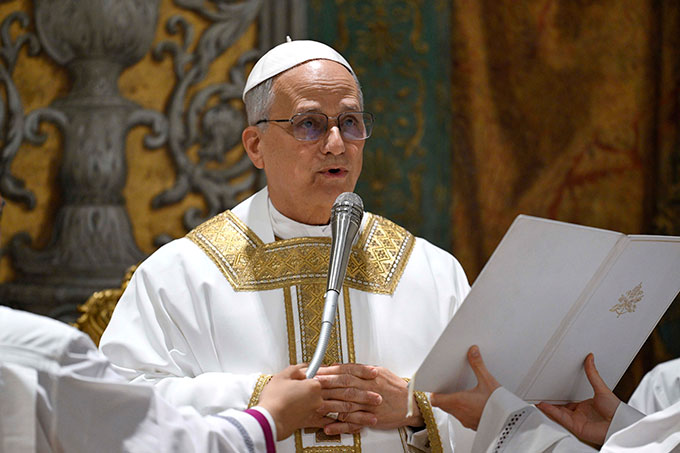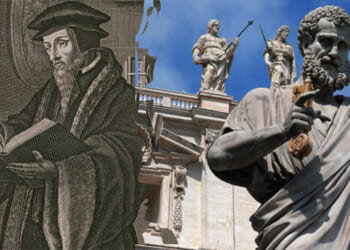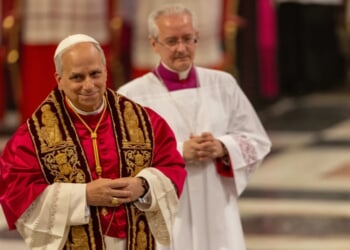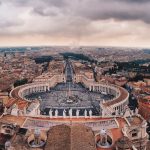On May 7, Robert Francis Prevost entered the Sistine Chapel as a dark-horse cardinal from Chicago. A day later, after securing the votes of at least 89 out of his 132 peers, he appeared on the balcony of St. Peter’s Basilica as Pope Leo XIV, the first Bishop of Rome from the United States and North America. Now the supreme pontiff of the world’s 1.3 billion Catholics, the 267th successor of Saint Peter has a shared opportunity alongside his native country to shape the moral and political character of the twenty-first century.
As speculation mounted over who would follow Pope Francis, Prevost barely registered on papabile radars. The conventional wisdom among Vatican watchers and commentators was that an American as pope would concentrate too much power and influence in the already-dominant United States. In an ironic twist, Francis, who named 108 of the 133 electors, repeatedly called for the Church to reach out to its “peripheries,” elevating those overseeing far-flung dioceses while leaving places like Paris, Los Angeles, Krakow, Milan, and Venice without votes. The electors, however, saw no reason to bar a candidate from the global superpower, though someone with extensive experience as a missionary in Peru and service in the Roman Curia.
Finally, a reason to check your email.
Sign up for our free newsletter today.
Prevost had received his cardinal’s biretta less than two years ago, but he had a consistent track record of skilled administration. He led the 2,800-member Augustinian religious order for 12 years, the Diocese of Chiclayo, Peru for nine, and most recently the Vatican’s body that determines the selection of new bishops.
The cardinals probably viewed Prevost’s relative media obscurity as an asset. With few preconceptions about his stances on hot-button social issues, liturgical reform, and Francis’s efforts to make the Church more dialogical (“synodality,” in Church jargon), Prevost was palatable both to progressives and conservatives.
His choice of the name Leo struck a decidedly middle path. It harkened to his most immediate namesake, Leo XIII, whose social teachings emphasized the primacy of human dignity during the height of the Industrial Revolution while reasserting traditional approaches to the Church’s dogma. In his first appearance on the balcony of St. Peter’s Basilica, conservatives relished his wearing the red papal mozetta shoulder cape and embroidered stole—which Francis shunned in his first appearance—while progressives cheered his extemporaneous Spanish address to the people of his former diocese in Peru.
That approach will give Leo a mostly free hand to claim continuity with Francis while returning to the doctrinal clarity and liturgical richness of Popes John Paul II and Benedict XVI. One of Leo’s pressing tasks is to overhaul the Vatican’s structural operating deficits and underfunded pensions. As Francis discovered, financial reform inevitably faces resistance, but as a former member of the Curia, Leo knows its ways.
His relative obscurity also creates a window of opportunity politically. Reporters quickly found Prevost’s voting record in Illinois from 2008 to 2024, uncovering that he routinely opted to vote in the state’s Republican primaries. That may warm him to some in the White House. As bishop and cardinal, he mostly kept a low profile on social media, though he occasionally reposted articles critical of the Trump administration’s immigration stances. Recently, he shared an article that criticized Vice President J. D. Vance’s understanding of a Catholic concept on the proper structuring of one’s obligations and loves, first to those who are nearest, and radiating outwards.
Though these criticisms may hint at future tensions between president and pope, as bishop, Prevost deftly navigated his Peruvian diocese through years of political instability. He did so often by alleviating concrete needs of the poor, building a large and loyal following. Trump, who carried the U.S. Catholic vote decisively, will need it in next year’s midterm elections. After Trump’s Truth Social account posted a tasteless AI-generated image of the president as pope, the backlash caused the president to distance himself from it.
Following a fraught relationship between Francis and the U.S., the election of an American as his successor signals the Catholic Church’s openness to align with the United States as the political leader of the free world in the dawn of a multipolar era. The electors’ passing over of the frontrunner, Cardinal Secretary of State Pietro Parolin, suggests that many disapproved of a deal he negotiated giving the Chinese government a say over the appointment of the country’s bishops.
Leo’s election coincided with Victory in Europe Day, the 80th anniversary of Nazism’s defeat on the continent made possible through American intervention. In his first Sunday Angelus address, Leo acknowledged the anniversary while calling for an end to global conflicts, including the return of hostages held by Hamas. A priest from the nation’s heartland now stands as the world’s foremost moral and spiritual voice.

On Friday, in his first homily as pope, Leo insisted that God had called him as pope to make the Church “ever more fully a city set on a hill, an ark of salvation sailing through the waters of history and a beacon that illumines the dark nights of this world.”
At February’s National Prayer Breakfast, Trump quoted John Winthrop, governor of the Massachusetts Bay Colony, stating that “America would stand as ‘a city upon a hill, a light to all nations with the eyes of all people upon us.’”
As white smoke ascended from the Sistine Chapel chimney, more commonalities between Church and nation took visible form. Throngs of worshipers and well-wishers filled the arms of Gian Lorenzo Bernini’s colonnade in St. Peter’s Square. Flags from around the world demonstrated the Church’s universal reach, embracing in common faith all the saints and sinners of a wounded world.
Shaped by the Judeo-Christian message, the United States has likewise woven people from different backgrounds, creeds, and cultures into a greater unity. The American experiment is bound together by its founding ideals, that all men are created equal and that all should have an opportunity to make the most of their talents.
America celebrates second chances. The difference between success and failure is, most often, giving up. For the Church, too, no failing is final, no offense unforgivable, no person beyond redemption.
Catholicism and Americanism share the convictions that so-called ordinary people matter and can do extraordinary things. A carpenter, leading twelve simple fishermen and tax collectors from Galilee—a provincial backwater—transformed the paganized Roman world. All but one suffered brutal execution, yet three centuries later, their successors conquered the same empire. They, like countless American leaders and entrepreneurs, seized the moment.
In their own ways, the Church and the United States have served as forces of peace and defenders of human dignity. At times, neither has lived up to its own ideals. But neither has given up. Deep internal divisions have racked both throughout their histories. They have endured, bruised but intact.
For two centuries, the thought of an American pope was suitable only as fantasy. Then it happened in barely a day, ushering in the Leonine Era.
Top Photo by Francesco Sforza – Vatican Media via Vatican Pool/Getty Images
Source link


















